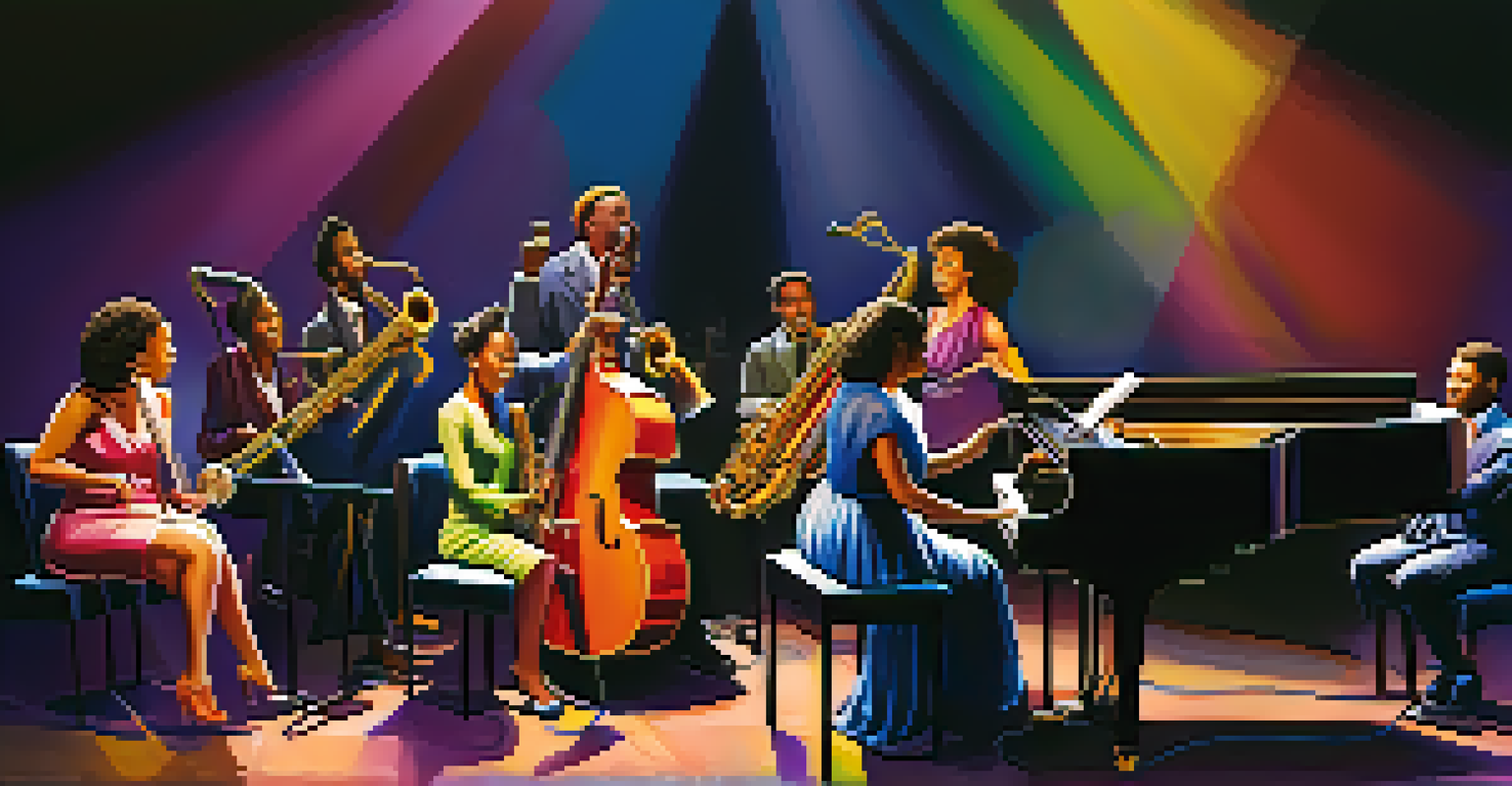The Legacy of Women in Jazz: A Historical Perspective

The Early Pioneers: Women Who Shaped Jazz
In the early 20th century, women began to break into the male-dominated world of jazz. Artists like Lil Hardin Armstrong and Jelly Roll Morton's wife, Anita, were instrumental in forming the sound of early jazz. Their contributions often went unrecognized, but they laid the groundwork for future generations of female musicians.
It's not about the music. It's about the fight for recognition and respect in a world that often overlooks the contributions of women.
These pioneers faced significant challenges, from societal expectations to the limitations placed on them within the music industry. Despite this, their passion for jazz pushed them to the forefront, inspiring other women to take up instruments and perform. Their legacy can still be felt in the vibrant jazz scene we know today.
Through their resilience and creativity, these women not only shaped the genre but also paved the way for others to follow. Their stories remind us that the history of jazz is not just about the music—it's about the people behind it.
Jazz in the 1930s and 1940s: The Rise of Female Icons
The 1930s and 1940s marked a significant shift in the jazz landscape, with women like Billie Holiday and Ella Fitzgerald rising to prominence. Their unique voices and emotional performances captivated audiences and brought a new depth to jazz music. These artists became household names, showcasing the power of female talent in a genre often dominated by men.

During this period, women not only sang but also took on roles as bandleaders and composers, challenging gender norms. Their ability to navigate and thrive in a challenging environment was nothing short of remarkable. For instance, Mary Lou Williams, a talented pianist and composer, played a crucial role in shaping the sound of big band jazz.
Women Pioneers in Early Jazz
Early female artists like Lil Hardin Armstrong and Anita Morton laid the foundation for future generations in a male-dominated genre.
The impact of these female icons goes beyond their musical contributions; they also served as role models for aspiring musicians. Their success stories encouraged many young women to pursue careers in music, changing the face of jazz for future generations.
The Social Changes in the 1960s: Women in Jazz
The social upheaval of the 1960s brought about significant changes in the music industry, including jazz. Women like Nina Simone and Abbey Lincoln used their music as a platform to address social issues, including civil rights and feminism. Their powerful lyrics and performances resonated with audiences, making their voices an essential part of the jazz narrative.
I think a lot of people are afraid of what they don't know, and jazz is a perfect example of that. It's about breaking down barriers and embracing diversity.
As the civil rights movement gained momentum, female jazz musicians became increasingly vocal about their experiences and struggles. This newfound activism within their music not only highlighted social injustices but also inspired a sense of community and empowerment among listeners. Nina Simone, in particular, became a symbol of resistance, using her art to advocate for change.
This era showcased the versatility of women in jazz, proving that they were not just entertainers but also influential figures in societal movements. Their contributions during this time helped to redefine the role of women in music and set the stage for future artists.
Fusing Genres: Women in Jazz, Rock, and Beyond
As jazz continued to evolve, many female musicians began to experiment with fusing genres, creating unique sounds that blended jazz with rock, funk, and other styles. Artists like Joni Mitchell and Esperanza Spalding pushed the boundaries of jazz, incorporating elements from various musical traditions. This fusion not only enriched the genre but also attracted a broader audience.
These innovative musicians demonstrated that jazz could adapt and thrive in a changing musical landscape. Their willingness to explore new sounds and influences highlighted the creativity and versatility of women in jazz. By breaking genre barriers, they opened doors for future artists to express themselves freely and authentically.
Female Icons in Jazz's Golden Age
The 1930s and 1940s saw the rise of influential women like Billie Holiday and Ella Fitzgerald, who became role models for aspiring musicians.
The fusion of genres brought a fresh perspective to jazz, with women at the forefront of this movement. Their ability to blend styles exemplified the power of collaboration and the importance of diversity in music.
Modern Jazz: Contemporary Women Leading the Scene
Today, women continue to play a vital role in shaping the jazz scene, with artists like Kamasi Washington and Norah Jones gaining international acclaim. These contemporary musicians bring their unique experiences and perspectives to the genre, ensuring that jazz remains dynamic and relevant. Their success highlights the progress made since the early days of jazz, where women were often overlooked.
Modern female jazz musicians are not just performers; they are also producers, composers, and bandleaders. They are taking charge of their careers and making significant contributions to the industry. With the rise of technology, many women are using platforms like social media to share their music, connect with fans, and build their brands.
This new wave of female talent is inspiring a new generation of musicians, proving that the legacy of women in jazz is alive and well. Their contributions continue to enrich the genre and highlight the importance of diversity in music.
Overcoming Challenges: The Fight for Recognition
Despite the significant contributions of women in jazz, many still face challenges in gaining recognition and respect. The music industry has historically been male-dominated, making it difficult for female artists to secure opportunities. Issues such as pay inequality and limited representation in festivals and concerts persist, highlighting the need for continued advocacy.
Many women are actively working to change the narrative by creating spaces for themselves and others. Organizations and initiatives focused on supporting female musicians aim to provide resources, mentorship, and visibility. These efforts are crucial in ensuring that the legacy of women in jazz is not only acknowledged but celebrated.
Modern Challenges and Recognition
Despite significant contributions, women in jazz continue to fight for recognition and equality in an industry still dominated by men.
The fight for recognition is ongoing, but the resilience and determination of female jazz musicians are paving the way for future generations. By addressing these challenges head-on, they are not only preserving their legacy but also ensuring a more equitable future for all musicians.
The Legacy Continues: Inspiring Future Generations
The legacy of women in jazz is not just a reflection of the past; it is a source of inspiration for future generations. Young female musicians today are stepping into the spotlight, drawing from the rich history of those who came before them. Their stories and experiences serve as a reminder that talent knows no gender.
Mentorship and support networks are essential in fostering the next wave of female jazz artists. Programs that connect young musicians with seasoned professionals help nurture talent and build confidence. By sharing their knowledge and experiences, established artists can empower the next generation to pursue their dreams in the jazz world.

As we celebrate the legacy of women in jazz, we also look forward to a future where their contributions are recognized and valued. The continued passion and creativity of female musicians will undoubtedly shape the evolution of jazz for years to come.